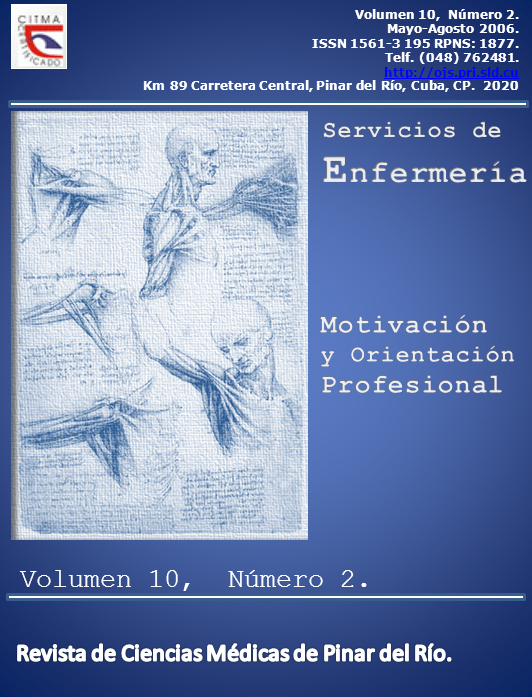Determinación de potenciales de riesgo de accidentes en el hogar. Determining Domestic Accident RiskPotentials
Abstract
La palabra accidente, por su significado habitual se define como un suceso casual, fortuito debido a la suerte, al azar y no se trata de suerte o casualidad, sino que en los hogares se encuentran los distintos objetos que propician estos tristes acontecimientos que en muchas ocasiones pueden ser evitados, para lo cual nos propusimos determinar los potenciales de riesgo de accidentes en el hogar a través de un estudio observacional, descriptivo, en los meses de Enero a Septiembre del año 2006, al universo: 629 hogares pertenecientes al consultorio del médico de la familia No 85 del Policlínico "Hermanos Cruz" de Pinar del Río. La muestra estuvo constituida por 135 familias, que tuviesen como característica la presencia en ella de un niño entre 0 y 15 años y/o un anciano (+ 60 años). La información se obtuvo mediante la observación directa del hogar, entrevista con los pobladores para determinar el tipo de potencial de riesgo existente en el hogar. Se utilizó el método de la Estadística Descriptiva. Se encontró que el 45.5 % de los hogares posee riesgos de accidentes, y el tipo de potencial de riesgo encontrado se relaciona con la corriente eléctrica. Los medios de difusión masiva son la principal vía de obtención de la información. El mayor por ciento de potencial de riesgo de accidente por corriente eléctrica se reporta por tomacorrientes sin tapas y en mal estado.
Palabras clave: ACCIDENTES, POTENCIAL DE RIESGO.
ABSTRACT
The word accident, according to its usual meaning, is defined as a casual event, but indeed it is not always due to chance or hazard. Accidents can occur at home because of the presence of different devices capable of producing fatal events which can be avoided, so the purpose of this article is to assess the accident risk potentials at home by means of an observational descriptive study during January-September 2006 on the whole sample which comprised 629 homes belonging to Family Doctor's Office # 85 of "Hermanos Cruz" Polyclinic in Pinar del Río. The sample comprised 135 families who had a child ranging from 0 to 15 years of age and/or an aged person (over 60 years of age). The information was obtained through a direct observation of homes, interviews with people to determine the type of risk potential existing at home. The Descriptive Statistical Method was used. It was found that 45,5% of all homes have risks of accidents, and the type of risk potential found was related to electrical current. The media are the main way to obtain information. The highest percentage of risk potential of accidents by electrical current is reported because of uncovered outlets in bad conditions.
Key words: ACCIDENTS, RISK POTENTIAL.
Downloads
How to Cite
Issue
Section
License
Authors who have publications with this journal agree to the following terms: Authors will retain their copyrights and grant the journal the right of first publication of their work, which will be publication of their work, which will be simultaneously subject to the Creative Commons Attribution License (CC-BY-NC 4.0) that allows third parties to share the work as long as its author and first publication in this journal are indicated.
Authors may adopt other non-exclusive license agreements for distribution of the published version of the work (e.g.: deposit it in an institutional telematic archive or publish it in a volume). Likewise, and according to the recommendations of the Medical Sciences Editorial (ECIMED), authors must declare in each article their contribution according to the CRediT taxonomy (contributor roles). This taxonomy includes 14 roles, which can be used to represent the tasks typically performed by contributors in scientific academic production. It should be consulted in monograph) whenever initial publication in this journal is indicated. Authors are allowed and encouraged to disseminate their work through the Internet (e.g., in institutional telematic archives or on their web page) before and during the submission process, which may produce interesting exchanges and increase citations of the published work. (See The effect of open access). https://casrai.org/credit/



